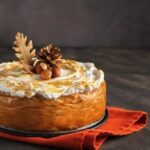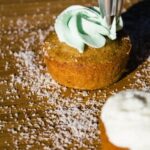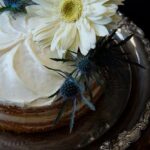Are you looking to learn how to decorate the side of a cake with buttercream? Buttercream has long been a favorite in the world of cake decorating, known for its smooth texture and versatile nature. In this article, we will explore the art of buttercream cake decorating, starting with the basics of understanding different types of buttercream and their consistencies.
Before diving into the actual process of decorating, it’s important to prepare the cake properly by leveling it and applying a crumb coat. Additionally, having the right tools and supplies for buttercream side decoration is essential for achieving professional-looking results.
Once we have covered the basics, we will provide you with a step-by-step tutorial on creating a smooth buttercream finish on the side of your cake. We’ll also explore various techniques for adding textures and designs using buttercream, as well as troubleshooting common issues that may arise during the decorating process.
Whether you’re a beginner or an experienced baker looking to enhance your skills, mastering the art of decorating cake sides with buttercream can elevate the overall aesthetic appeal of your creations. So, let’s get started on this delicious journey into the world of buttercream cake decorating.
Understanding the Basics of Buttercream
Buttercream is a versatile and popular frosting for cake decorating, known for its smooth texture and ability to hold different shapes and designs. Understanding the basics of buttercream, including the different types and consistency, is crucial for achieving beautifully decorated cakes.
Types of Buttercream
There are several types of buttercream, including American buttercream, Swiss meringue buttercream, Italian meringue buttercream, and French buttercream. Each type has its own unique flavor and texture, with American buttercream being the simplest to make and the sweetest in taste, while Swiss meringue and Italian meringue buttercreams have a smoother texture and less sweetness.
Consistency of Buttercream
The consistency of buttercream is essential for cake decorating. A stiff or firm consistency is ideal for piping decorations such as flowers and intricate designs. On the other hand, a softer consistency is better for spreading a smooth finish on the sides of the cake. It’s important to achieve the right consistency by adjusting the amount of powdered sugar or liquid in your buttercream recipe.
Learning about the different types of buttercream and understanding how to achieve the right consistency will help you master the art of decorating cake sides with buttercream. With this knowledge, you can confidently move on to preparing your cake for decoration and selecting the appropriate tools and supplies needed for this process.
Preparing the Cake for Decorating
Leveling and crumb coating are essential steps in preparing a cake for buttercream decoration. Leveling the cake ensures an even surface, while crumb coating helps to seal in moisture and provide a smooth base for the final layer of buttercream.
To level a cake, you will need a long serrated knife or a cake leveler. Place the cake on a flat surface and carefully trim off any domed or uneven areas to create a level top. Take your time with this step to ensure that the cake is evenly leveled and does not have any uneven surfaces that could affect the final appearance.
Once the cake is leveled, it’s time to apply a crumb coat. A crumb coat is a thin layer of buttercream that seals in any loose crumbs on the surface of the cake.
To do this, simply cover the entire cake with a thin layer of buttercream, making sure to spread it evenly and smoothly. This will help to prevent any crumbs from getting into the final layer of buttercream and will create a clean, polished look for your decorated cake.
After leveling and applying a crumb coat, your cake is now ready for decorating with buttercream. These crucial steps ensure that your final product not only looks professional but also tastes delicious by maintaining its moisture with every bite.
Tools and Supplies for Buttercream Side Decoration
When it comes to decorating the side of a cake with buttercream, having the right tools and supplies is essential for achieving a professional-looking finish. From spatulas to piping bags, each item serves a specific purpose in creating beautiful designs and textures on the cake’s side.
Essential Tools
One of the most important tools for buttercream side decoration is an offset spatula. This allows for smooth and precise application of the buttercream onto the cake’s sides. Additionally, a bench scraper is useful for achieving sharp edges and ensuring an even coating of buttercream around the cake. Piping tips and bags are also necessary for creating intricate designs and patterns on the side of the cake.
Supplies
In addition to tools, having the right supplies is crucial for successful buttercream side decoration. High-quality buttercream is essential, as its consistency greatly impacts the final result. Food coloring gels or powders can be used to achieve vibrant or pastel colors for your designs. It’s also important to have cake boards or turntables to easily maneuver and decorate the cake while ensuring an even finish.
Step-by-Step Tutorial
Creating a smooth buttercream finish on the side of a cake is an essential skill for any baker or cake decorator. It provides a clean, polished look that serves as the perfect canvas for adding further decorations and designs. To achieve this, you will need a few key tools and the right consistency of buttercream.
First, make sure you have a turntable to easily rotate the cake while applying the buttercream. This will help you achieve an even finish around the entire cake. Additionally, an offset spatula is crucial for smoothing the buttercream and removing any excess.
When it comes to achieving the right consistency of buttercream, it should be soft enough to spread easily but not so runny that it creates a mess. The ideal texture is one that holds its shape when piped or spread but is still smooth and pliable.
To begin creating a smooth buttercream finish on the sides of your cake, apply a thin layer of buttercream around the entire cake to seal in any crumbs (also known as crumb coating). This will provide a smooth base for adding the final layer of buttercream. Once your crumb coat has set, you can then apply a thicker layer of buttercream and use your offset spatula to smooth it out.
With these techniques and tools in hand, you can achieve a professional-looking smooth finish on the side of your cake, providing the perfect foundation for adding additional decorations and designs. Let your creativity flow as you master this fundamental skill in cake decorating.
| Tools Needed | Buttercream Consistency |
|---|---|
| Turntable | Soft but holds shape |
| Offset spatula | Smooth and pliable |
Adding Textures and Designs
When it comes to decorating the sides of a cake with buttercream, there are various techniques that can be used to add textures and designs. These techniques not only enhance the visual appeal of the cake but also provide depth and dimension to the overall decoration. Here are some popular techniques for creating stunning buttercream side decorations:
- Offset Spatula Technique: Using an offset spatula, you can create smooth vertical stripes or textured horizontal lines on the sides of the cake. This technique allows for precise control over the design and is perfect for achieving clean, modern looks.
- Piping Technique: Piping buttercream onto the sides of the cake using different tips can create a range of patterns and designs, such as shells, rosettes, or basketweave. This versatile technique offers endless possibilities for creative expression and customization.
- Spatula Painting Technique: By applying a thin layer of buttercream on the sides of the cake with a spatula and then gently blending colors together, you can achieve a beautiful painted effect. This technique is ideal for creating ombre or watercolor-inspired designs.
These techniques can be used individually or combined to create elaborate and unique decorations on the sides of your cakes. Experimenting with different tools and methods will allow you to discover your own signature style in buttercream side decorating.
Remember that practice makes perfect when it comes to mastering these techniques, so don’t be afraid to try out new ideas and refine your skills. With patience and creativity, you’ll be able to elevate your buttercream side decorations to professional levels in no time.
Troubleshooting
While decorating the side of a cake with buttercream can result in stunning and professional-looking desserts, there are some common issues that may arise during the process. Fortunately, there are solutions to these problems that can help you achieve the perfect finish on your cake.
One of the most common issues when decorating a cake with buttercream is air bubbles forming in the icing, which can create an uneven and unappealing texture. To prevent this, make sure to properly mix and prepare your buttercream before applying it to the cake. Additionally, using a bench scraper or offset spatula to smooth the buttercream onto the sides of the cake can help eliminate air bubbles.
Another common problem when working with buttercream is achieving consistent thickness and coverage on the sides of the cake. This can be solved by ensuring that your crumb coat is applied evenly and smoothly before adding the final layer of buttercream. Taking your time to spread and smooth the icing will also help create a uniform finish.
Finally, color consistency can be an issue when working with tinted buttercream. To avoid streaks or uneven coloring on the sides of your cake, be sure to thoroughly incorporate any food coloring into your icing. You can also achieve a more cohesive look by dividing your buttercream into smaller portions and coloring them separately before recombining for a consistent hue.
When troubleshooting these common issues, it’s important to remember that practice makes perfect. The more you work with buttercream and practice different techniques for side decorating, the better you’ll become at identifying and solving potential problems.
| Issue | Solution |
|---|---|
| Air bubbles in icing | Properly mix and prepare buttercream; use bench scraper or offset spatula to smooth icing |
| Inconsistent thickness/coverage | Apply even crumb coat; take time to spread and smooth icing |
| Inconsistent coloring | Thoroughly incorporate food coloring into icing; divide & color smaller portions before recombining |
Final Touches
After creating a smooth buttercream finish and adding textures or designs to the sides of the cake, the final touches involve enhancing the overall aesthetic appeal with buttercream accents. This step allows for further customization and personalization of the cake, adding an extra level of detail and visual interest.
One popular way to enhance the overall aesthetic appeal is by using piping techniques to create decorative borders or patterns on the top and bottom edges of the cake. This can be achieved using different piping tips to create various designs such as swirls, rosettes, shells, or zigzags. These buttercream accents not only add visual appeal but also provide a finished look to the cake.
Another way to elevate the appearance of the cake is by incorporating edible decorations such as fresh fruits, flowers, or edible pearls onto the buttercream accents. These embellishments not only add color and texture but also contribute to the overall theme or style of the cake. It’s important to ensure that any non-edible elements are food-safe and secured properly to avoid any mishaps.
Lastly, consider adding a personalized touch by incorporating written messages or monograms using piped buttercream onto the side of the cake. This can be done using a small round piping tip and a contrasting color of buttercream to make the message stand out. Whether it’s a celebratory message for a special occasion or simply initials for a personalized touch, this final detail adds sentiment and uniqueness to the cake.
Conclusion
In conclusion, mastering the art of decorating cake sides with buttercream can truly elevate the overall look and appeal of your baked creations. Understanding the basics of buttercream, preparing the cake for decorating, and having the right tools and supplies are essential steps in achieving a beautifully decorated cake.
The step-by-step tutorial provided in this article offers a comprehensive guide to creating a smooth buttercream finish, while also exploring techniques for adding textures and designs to the cake sides.
As with any skill, practice makes perfect when it comes to buttercream side decoration. Don’t be discouraged by any common issues that may arise – instead, use them as learning opportunities to improve your technique. By troubleshooting and finding solutions to these issues, you’ll become more confident and skilled in the art of buttercream cake decorating.
Lastly, always remember that final touches can make all the difference in enhancing the overall aesthetic appeal of your cake. Whether it’s adding floral accents, piping intricate designs, or incorporating edible decorations, these finishing touches will showcase your creativity and attention to detail. With dedication and patience, you can truly master the art of decorating cake sides with buttercream and delight friends and family with your beautifully adorned cakes.
Frequently Asked Questions
How Do You Put Buttercream on the Side of a Cake?
To put buttercream on the side of a cake, start by crumb coating the entire cake with a thin layer of buttercream to seal in any loose crumbs. Then, use a offset spatula to spread a thicker layer of buttercream onto the sides, using smooth and even strokes.
It’s important to work quickly but carefully to prevent the buttercream from drying out or getting too soft.
How Do You Get Decorations to Stick to the Side of a Cake?
Getting decorations to stick to the side of a cake can be achieved by gently pressing them into the buttercream while it is still soft and slightly tacky. You can also try lightly brushing the back of the decorations with a small amount of clear piping gel or simple syrup before placing them onto the cake.
This will help them adhere more securely.
How Thick Should Buttercream Be on Sides of Cake?
The ideal thickness for buttercream on the sides of a cake is about 1/4 inch. This thickness allows for enough coverage without being too heavy or overwhelming in texture when eating the cake. It should be smooth, evenly distributed, and free from any air bubbles or gaps between layers.

Welcome to my blog about home and family. This blog is a place where I will share my thoughts, ideas, and experiences related to these important topics. I am a stay-at-home mom with two young children. I hope you enjoy reading it! and may find some helpful tips and ideas that will make your home and family life even better!





